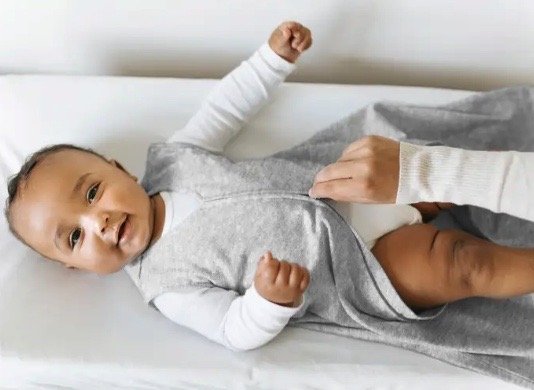Why choose wearable blankets (ex: Halo Sleepsack)
Note that this post is not sponsored; the opinions shared here are my own. This post may have affiliate links, which means I may receive commissions if you choose to purchase through links I provide (at no extra cost to you). As an Amazon Associate, I earn from qualifying purchases. Read more about these links in my disclosure policy.
As a parent, you make countless choices. One of the most important choices you make in your baby’s early days is how, where, and in what your baby sleeps. For many reasons, wearable blankets have been a daily fixture in each of my four kids’ sleep environment. Let’s explore the advantages of incorporating wearable blankets into your baby’s bedtime routine, fostering comfort, safety, and peaceful nights. We’ll use the Halo Sleepsack as the example in this article given its incredible popularity and sky-high reviews. Also, it’s been a personal favorite of my family for all four of my kids. That being said, rest assured that there are other great wearable blanket options available on the market as well.
warmth and comfort without the risks
Safety is a top priority when it comes to your baby's sleep environment. Wearable blankets provide a much safer alternative to traditional blankets, eliminating the risk of loose fabric covering your baby's face. By adhering to safe sleep practices, wearable blankets ensure your little one stays comfortably covered without risk or compromise. Wearable blankets eliminate the need for any other blankets, sheets, or other loose fabric in the crib with your baby and allow you to practice the “ABCs of Safe Sleep” recommended by the American Academy of Pediatrics (baby should be Alone, on their Back, in their Crib). Click here to learn more about the AAP’s Safe Sleep Recommendations.
2. easy nighttime diaper changes
The Halo Sleepsack and many other wearable blankets make nighttime diaper changes—an inescapable part of parenting in those early weeks and months—simple and easy. With a quick zip (no snaps—trust me, avoid the snaps!!) from the bottom of the sleep sack, you can easily access your baby’s diaper without having to fully undress them. This can make the process of getting baby back to sleep after a nighttime diaper change a lot easier and faster for tired parents.
3. Versatility in fabrics to ensure baby’s comfort
Depending on the time of year, temperature inside your home, and what sort of pajamas baby is wearing, you want a wearable blanket that will provide baby just the right amount of warmth. Wearable blankets such as the Halo Sleepsack come in various styles and fabrics—everything from sleeveless to long-sleeves, and thin organic cotton or lightweight muslin to thicker micro-fleece.
4. Halo sleepsack swaddle is great for newborns
For younger babies who have not yet attempted to roll over, swaddles are a great choice to promote better sleep because they mimic the snug and cozy environment of the womb and inhibit an infant’s natural startle reflex. That said, correctly using a swaddle blanket in the middle of the night can be challenging for many exhausted parents. The Halo Sleepsack Swaddle is a velcro swaddle that is extremely easy to use and is adaptable to several different arm positions. With my kids, I started with the Halo Sleepsack Swaddle as newborns and then transitioned to the Halo Sleepsack wearable blanket once they started trying to roll over, usually somewhere around 3-4 months of age. One other benefit of the Halo Sleepsack Swaddle is that it is recognized by the International Hip Dysplasia Institute as having a roomy design that promotes healthy hip alignment.
Wearable blankets such as the halo sleepsack are great for parents and for babies
Personally, I wouldn’t skip adding the Halo Sleepsack to my baby registry. I would even be sure to add a few different sizes to ensure I had at least 2 of each size (baby messes happen, after all) through at least the first year. I’m still currently using one for all nighttime sleep and naps with my fourth baby who is eleven months old. I’ve been impressed with the durability of the Halo Sleepsack and still have some in great condition after 3 baby girls and plenty of times in the washer and dryer. Additionally, there are a lot of color, pattern, and personalization options available these days—many more than even 8 years ago when I received my first wearable blanket as a gift while pregnant with my first baby.
If you’re interested in learning other ways you can ensure great sleep for your baby, be sure to check out my ebook, the Ultimate Guide To Better Baby Sleep. As a pediatric sleep consultant and mom of four, I’ve learned a lot from both my personal experience as well as my expert training that can help you learn how to create healthy sleep patterns and habits for your baby—starting as soon as day 1 home from the hospital and without any crying. Sweet dreams to you and your baby!



